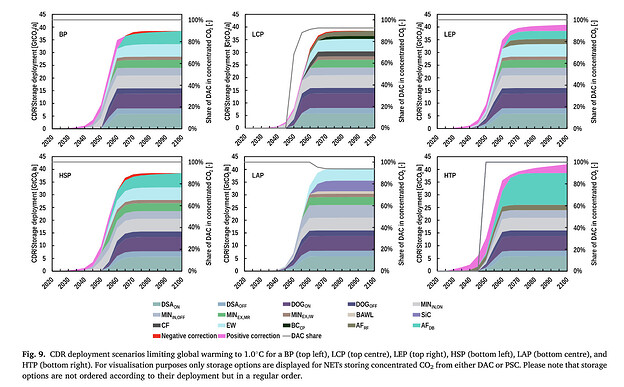This week, we take a deep dive into the main findings of the paper recently published in the International Journal of Greenhouse Gas Control. The study was led by Andreas Mühlbauer, together with a team of researchers from the Faculty of Electrical Engineering and Information Technology of OTH Regensburg in Regensburg (Germany) and the School of Energy Systems of LUT University in Lappeenranta (Finland).
This study evaluates various carbon dioxide removal (CDR) technologies by analyzing their economic feasibility and technological performance from a portfolio perspective. By modeling a portfolio of different CDR strategies, the study aims to determine an optimal mix of technologies that balances cost-effectiveness, scalability, and potential to meet global carbon removal targets. The LUT-CDR tool is introduced, which assesses CDR technology portfolios aligned with hypothetical societal preferences. Six scenarios are described, considering global deployment limitations, techno-economic factors, area requirements, technology readiness, and storage security for various CDR options. Feasibility and energy needs for large-scale CDR deployment are discussed, together with the differential role of the technologies included in the portfolios.
A variety of CDR technologies for which techno-economic parameters are available are included in the portfolios. CDR portfolios for different hypothetical societal preferences are obtained after calculating the global CDR potential, energy demand, area demand, and levelized cost of carbon dioxide removal (LCOCDR) of all NETs considered. Six portfolios are created, see Figure 9: (1) Balanced portfolio, with an equal distribution of preference weights over all societal factors; (2) Low-cost portfolio (LCP), with a preference for low-cost solutions; Low energy portfolio (LEP), with a preference for low energy demand solutions; High security portfolio (HSP), with a preference for solutions with low risk of CO2 leakage (high durability); Low area portfolio (LAP), with a preference for low land demand solutions; High TRL portfolio (HTP), with a preference for solutions with high level of technology readiness.
Results suggest the feasibility of large-scale CDR to meet the set climate targets, with a removal potential of 500–1750 GtCO2 by 2100. For a 1.0° C degree climate goal, CDR portfolios necessitate 12.0–37.5% more primary energy compared to a scenario without CDR. Remarkably, funding to meet the 1.0° C degree target would only require 0.42–0.65% of the projected global gross domestic product.
The most promising options appear to be secure sequestration of captured CO2 via direct air capture, electricity-based carbon sequestration, and desalination-based afforestation, while bioenergy carbon capture and sequestration and rainfall-based afforestation play limited roles. The study offers crucial techno-economic parameters for including CDR options in energy-industry-CDR system analyses demonstrating the tool’s flexibility.
Here is a list of the main takeaways from this paper:
- The paper analyzes the economic feasibility and scalability of various CDR technologies, focusing on cost per ton of CO2 removed across various approaches.
- A portfolio-based strategy is proposed to optimize the combination of CDR methods, addressing the trade-offs between cost, scalability, and technological readiness.
- The study highlights the relative potential of direct air capture, afforestation/reforestation, soil carbon sequestration, and ocean-based techniques.
- The study compares the potential of the different CDR methods, emphasizing the synergies between multiple CDR methods to scale up carbon removal effectively.
- The paper highlights the need for policies, financial incentives, and infrastructure to enable large-scale deployment of CDR portfolios.
Read the full paper here: Assessment of technologies and economics for carbon dioxide removal from a portfolio perspective
